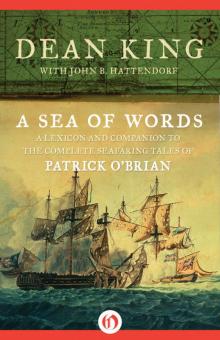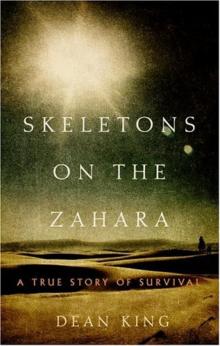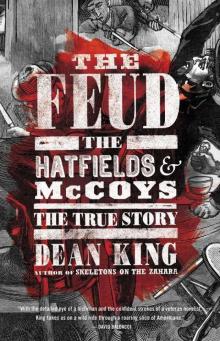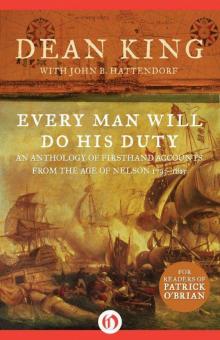A Sea of Words Read online
Page 7
Doctors also gave emetics, drugs that induce vomiting, to remove foul humors from the stomach, as well as to strengthen what they took to be weak stomach muscle fibers. Tartar emetic (antimony potassium tartrate) was administered for the same purposes, as was ipecac, which we still use to remove poisons from the stomach.
Diaphoretics, which Maturin called “anhidrotics,” made patients “sweat out” their unbalanced humors. At the same time these drugs— especially those made with antimony, like James’s Powder, a patent medicine that Maturin sometimes prescribed—were assumed to strengthen the blood vessels that supplied the sweat glands in the skin.
Opium and opium preparations such as laudanum (an alcoholic solution of opium also known as Thebaic tincture), were correctly regarded as sedative, antidiarrheal, and analgesic. Tolerance and addiction to opium were well known. Dr. Maturin used laudanum frequently as an escape from his worries. He appears to have been addicted to it, and it is unclear how he managed to wean himself from it. He believed that the coca leaves he discovered in Peru helped him overcome his reliance on opium, a common misconception even in the late 19th century.
Because syphilis was almost an occupational hazard of sailors, Navy Surgeons stocked various mercury salts with which to treat it. Most victims required prolonged therapy with oral mercury preparations, such as calomel or Maturin’s “blue pill,” and with unguents made with mercuric chloride. All mercurials were cathartic and diaphoretic, providing clear routes for the elimination of the contagious factor responsible for the affliction. However, it is unlikely that such treatments could have eradicated the syphilis organism.
Most doctors reserved two forms of treatment for their most seriously ill patients, especially those with the worst fevers or injuries. The first was the drug class called blisters, or epispastics, usually alcohol solutions of powdered cantharides beetles (sometimes called Spanish flies). When placed on the skin, this preparation does raise a large, painful blister. In humoral theory it was thought to draw foul humors into the blister fluid; solidist reasoning concluded that the artificially induced inflammatory blister would also neutralize the naturally occurring inflammation that had caused the patient’s symptoms by the process Maturin called “counter-irritation.”
The other relatively drastic treatment doctors favored was bleeding on the humoral grounds that it removed chemically or otherwise unbalanced blood that was producing symptoms and on the solidist grounds that it reduced tension of the hyperactive fibers of the fevered cardiovascular system. That is, releasing some of the patient’s blood was assumed to reduce the friction (between the blood and the walls of the arteries) that was producing the patient’s increased body heat. Doctors usually removed 12 ounces at a time but up to twice that amount from their sickest patients.
Maturin’s remedies were not designed to counteract well-defined disease processes, as modern drugs do. Instead he and his contemporaries used drugs to adjust or fine-tune a patient’s internal equilibria, his physiological balances, regardless of what might have disrupted them in the first place. The occurrence of catharsis, vomiting, sweating, or blisters after the administration of a corresponding drug simply confirmed that the remedy had indeed altered the humors, tones, and acid-base balance of the body in the intended way. However, few of these treatments could have provided truly effective cures.
Trauma and Surgery
During the ten years of naval warfare with France that culminated at Trafalgar in 1805, the Royal Navy had 1,483 men killed and 4,266 wounded in battle. That is only about 6 percent of the Navy’s total losses during that time; those from disease and individual accidents accounted for 82 percent, and major accidents (for example, sinking) 12 percent. Thus, although the Navy called most of its doctors Surgeons, because their principal task was to repair battle injuries, their surgical skills were needed far less frequently than were their general medical skills.
Although Maturin was trained as a physician, not a surgeon, he had at least read the most influential works on naval surgery that had been published by the time he met Aubrey, including the works of Gilbert Blane, James Lind, William Northcote, and Thomas Trotter. Among the common occupational risks of life at sea that might require manipulative surgical treatment were burns, inguinal hernias, falls from aloft, limbs crushed under falling barrels or by suddenly tightening ropes and chains, and injuries incurred during fights. Burns, which occurred not only in battle but also when guns misfired during exercises, were usually cleaned and dressed with olive oil. Hernias were reduced by manipulating the loop of intestine that had been forced into the scrotum so that it returned to the abdominal cavity, where it could be retained with a truss. Surgeons removed wens and superficial tumors and incised and drained large boils and abscesses. They occasionally cut through the lower abdomen and into the bladder to remove stones, as Maturin did on the Polychrest, and some removed cataracts from the eye, although most sailors were not old enough to need this operation. Navy Surgeons were also often required to examine men condemned to be flogged to ascertain whether they were fit for the punishment, and to treat their back wounds afterward.
Because dentistry had not yet separated from regular medical practice, doctors were also often called on to pull teeth, one of Maturin’s least favorite chores. For this purpose they used a clawlike device called a turnkey, or pelican, which gave them maximum leverage.
Doctors of Maturin’s time understood the basic principles of inflammation, even if some of their methods for dealing with it now seem bizarre. For instance, believing that blood could turn to pus during the inflammatory process, they bled seriously ill or wounded patients in order to reduce the accumulation of pus. The bacteria that actually cause its formation had not been discovered. But generally, Surgeons had sound principles concerning wound treatment: They controlled hemorrhage by tying off bleeding arteries, removed foreign bodies from wounds, and cleaned the wound sites. They thought some chemicals, such as nitrates, had “antiseptic” (literally, “anti-inflammatory”) properties, but they had no sure way of preventing infection. They attempted to close wound edges by clearing them of dead tissue and suturing them together. Afterward they inspected and changed dressings as often as possible to minimize inflammation and pus.
Ironically, more battle wounds occurred when ships fought at a distance than in close engagements. Cannonballs that had traveled a long distance caromed off masts and railings, creating dangerous large splinters. If surgeons could get to the arteries severed by these flying splinters, they could usually tie them off to stop the bleeding. For instance, during the fight with the Algerine pirate ship Dorthe Engelbrechtsdatter, Maturin ties off the “spouting femoral artery” in the leg of one of the Sophies.
Surgeons removed bullets with specially constructed “bullet forceps” or other tools, sometimes probing blindly through a muscle mass or into a wound in the chest or abdomen. They almost never opened those body cavities because they were well aware that the risk of fatal inflammation (infection) at those sites was nearly 100 percent. Men who were seriously burned by misfired guns, by explosions, or by very fast missiles that brushed their skin were treated with olive oil and ointments to soothe the affected areas and to prevent exposure to air.
During sea battles, the decks and cockpits could grow nightmarish. In his journal, Robert Young, Surgeon of the 64-gun H.M.S. Ardent at the battle of Camperdown, which began at about one P.M. on October 11, 1797, vividly describes the gory scene:
I was employed in operating and dressing till near 4.0 in the morning. ... So great was my fatigue that I began several amputations under a dread of sinking before I should have secured the blood vessels. [Young had no Surgeon’s Mates to assist him.]
Ninety wounded were brought down during the action. The whole cockpit deck, cabins, ... together with my [operating] platform and my preparations for dressing were covered with them. So that for a time they were laid on each other at the foot of the ladder where they were brought down, and I was obliged to go on deck to
the Commanding Officer to ... apply for men to go down the main hatchway and move the foremost of the wounded further forward ... and thus make room in the cockpit. Numbers, about sixteen, mortally wounded, died after they were brought down.... Joseph Bonheur had his right thigh taken off by a cannon shot close to the pelvis, so it was impossible to apply a tourniquet; his right arm was also shot to pieces. The stump of the thigh, which was very fleshy, presented a dreadful and large surface of mangled flesh. In this state he lived near two hours, perfectly sensible and incessantly calling out in a strong voice to me to assist him. The bleeding from the femoral artery [the main artery of the leg], although so high up, must have been very inconsiderable, and I observed that it did not bleed as he lay. All the service I could render this unfortunate man was to put dressings over the [wound] and give him drink.
Melancholy cries for assistance were addressed to me from every side by wounded and dying, and piteous moans and bewailing from pain and despair. In the midst of these agonising scenes, I was able to preserve myself firm and collected, and ... to direct my attention where the greatest and most essential services could be performed. Some with wounds, bad indeed and painful, but slight in comparison with the dreadful condition of others, were most vociferous for my assistance. These I was obliged to reprimand with severity, as their voices disturbed the last moments of the dying....
An explosion of a salt box with several cartridges abreast of the cockpit hatchway filled the hatchway with flame and in a moment 14 or 15 wretches tumbled down upon each other, their faces black as a cinder, their clothes blown to shatters and their hats afire. A Corporal of Marines lived two hours after the action with all the [buttocks] muscles shot away, so as to excavate the pelvis. Captain Burgess’ wound was of this nature, but he fortunately died almost instantly.
After the action ceased, 15 or 16 dead bodies were removed before it was possible to get a platform cleared and come at the materials for operating and dressing, those I had prepared being covered over with bodies and blood, and the store room blocked up.
I have the satisfaction to say that of those who survived to undergo amputation or be dressed, all were found the next morning in the gunroom, where they were placed, in as comfortable a state as possible, and on the third day were conveyed on shore in good spirits.... (Christopher Lloyd and Jack L. S. Coulter, Medicine and the Navy, 1200-1900, vol. 3, 1714-1815 [Edinburgh: E. and S. Livingstone Ltd., 1961], pp. 58-60)
The Ardent suffered the most losses of the British fleet in that action, 41 killed and 107 wounded, including among the dead her captain.
Another firsthand account, by seaman Samuel Leech of H.M.S. Macedonian when she was defeated in a one-sided battle by the American frigate United States in October 1812, focuses on the Surgeon:
The first object I met was a man bearing a limb, which had just been detached from some suffering wretch.... The surgeon and his mate were smeared with blood from head to foot: they looked more like butchers than doctors. Having so many patients [36 were killed and 68 wounded], they had once shifted their quarters from the cockpit to the steerage; they now removed to the wardroom, and the long table, round which the officers had sat over so many a feast, was soon covered with the bleeding forms of maimed and mutilated seamen....
Our carpenter, named Reed, had his leg cut off. I helped to carry him to the after wardroom, but he soon breathed out his life there, and then I assisted in throwing his mangled remains overboard.... It was with exceeding difficulty I moved through the steerage, it was so covered with mangled men and so slippery with blood.
We found two of our mess wounded. We held [one man] while the surgeon cut off his leg above the knee. The task was most painful to behold, the surgeon using his knife and saw on human flesh and bones as freely as the butcher at the shambles. (Ibid., p. 61)
Hemorrhage was the greatest immediate hazard of battle wounds, especially those made by swords, bayonets, or large splinters. Bleeding from limbs was stopped by canvas tourniquets tightened by turning a screw to compress a brass plate positioned over the bleeding artery. Bleeding from the head and torso could be controlled only by compression bandages. Only after bleeding had been minimized could the surgeon proceed to correct the damage.
Eighteenth-century surgeons could perform a wide range of operations. The most frequent capital operations (those with the greatest risk of death) were amputations. Simple fractures and dislocations of arms and legs were reduced and splinted, but compound fractures associated with open wounds were likely to be followed by gangrene, which required operation. By 1800 some surgeons were able to cut through the muscles of the thigh with a knife and saw through the femur beneath them so rapidly that patients felt the excruciating pain for no more than two minutes.
Some operations were not standard, of course—on the contrary, they had to be improvised according to the nature of the patient’s wound. For instance, a few surgeons made successful extemporaneous attempts to remove the entire arm along with the shoulder blade and collar bone; other joints were also removed, but rarely.
Trepanning, or trephining, was another rare capital operation. It involved cutting a disk about an inch or so in diameter from the skull to remove bone that had been fragmented by blunt trauma or shot, and to relieve pressure on the swelling brain beneath. Dr. Maturin won his reputation during his first voyage with Aubrey by this operation, which he later said he had performed “many times” without failure. Indeed, not long after he trepanned Joe Plaice for a depressed skull fracture, the Surgeon himself was knocked out when his head struck a gun on a Pacific island controlled by potentially hostile American whalers. Mr. Martin, the chaplain, could feel no underlying fracture and diagnosed a blood clot as the cause of Maturin’s continuing coma. The Americans’ surgeon, Dr. Butcher, was about to trepan Maturin in order to remove the clot when the patient was mercifully and humorously jolted into consciousness when a bit of snuff accidentally fell into his nostrils.
Because general anesthesia was not introduced until 1846, surgeons had to strap their patients into place or have them held down during major operations. They may have used rum or opium to minimize the patient’s response to pain and to relax his muscles, but evidence of the routine use of such general depressants is difficult to find. Of course, many patients became suitably unresponsive after going into shock when the pain became sufficiently intense.
Olive oil was usually applied to burns, to keep the skin soft while it healed. The more complex ointments commonly applied to surgical sites were made with mixtures of oils and fats; lead salts were included in some of them because they were thought to help keep the wound dry. If that succeeded, and if the wound could be kept clean, surgical patients had a good chance of actually benefiting from their doctors’ skills, even though the doctors were unaware of the relationship between bacteria and pus.
What Good Could Dr. Maturin’s Medicine Do?
With the exception of a small handful of drugs, such as opium and cinchona, it is clear that Maturin and his contemporaries were unable to provide truly effective remedies for the majority of their nonsurgical patients. Nevertheless, most of them recovered. Fairly early in his naval career, Dr. Gilbert Blane could conclude that:
there is a tendency in acute diseases to wear themselves out, both in individuals that labour under them, and when the infection is introduced into a community [such as the crew of a ship]. Unless there were such a vis medicatrix [healing power of nature], there would be no end to the fatality of these distempers ... and those who happen not to be infected at first, become in some measure callous to its impression, by being habitually exposed to it.... Thus the most prevailing period of sickness is when men are new to their situation and to each other. (Observations on the Diseases Incident to Seamen [London: Cooper, 1785], pp. 66-67)
Blane, a strong proponent of keeping and examining naval medical statistics, was right. In the absence of devastating epidemics of illnesses like smallpox or yellow fever, about 90 to 96 percent of adult patients in t
he 18th century, civilian or naval, recovered after being treated by their doctors, regardless of what the physicians did.
Dr. St. Medard’s clinical notes on U.S.S. New-York bear this out. His patients with bad colds recovered the most rapidly, followed by those with uncomplicated diarrhea. Dysentery cases recovered more slowly, as did those with “bilious disorders” (probably hepatitis). Patients with typhus and other severe infections recovered the most slowly and the least frequently. But the great majority did recover, even though the only truly effective drug St. Medard had was the quinine in the cinchona he gave patients with malaria, who recovered about as promptly as those with bad colds.
The only major illness on New-York that her Surgeon could not treat successfully was scurvy, because he had no lemons, limes, or oranges on board. The other common illnesses eventually disappeared, thanks chiefly to the body’s built-in immune and tissue repair mechanisms. Scurvy was the only condition whose course could not possibly have been affected by the body’s usual repair mechanisms. It has only one cure or preventive, vitamin C.
The concept of the healing power of nature was not unknown to either Peter St. Medard or Stephen Maturin. Indeed, they and their colleagues saw their task as helping nature accomplish its job. Because their contributions to the restoration of healthy balances in humors, tones, and acidity were effective in 19 out of 20 patients, neither doctors nor their patients had any reason not to believe that they had contributed to their patients’ recovery.
It probably would have been hard to convince Jack Aubrey, who had great confidence in Stephen Maturin’s professional skills, that it was chiefly the surgical skills of naval doctors that contributed to the survival of wounded men at sea, and that the drugs they prescribed according to unproven (and unprovable) theories were effective only because the body is often able to heal itself. But perhaps that unblemished confidence worked to Aubrey and his crews’ benefit.

 A Sea of Words
A Sea of Words Skeletons on the Zahara
Skeletons on the Zahara The Feud: The Hatfields and McCoys: The True Story
The Feud: The Hatfields and McCoys: The True Story Every Man Will Do His Duty
Every Man Will Do His Duty 9/11...The Tragic Story of the Day that Changed America: The Terror, The Horror and The Heroes
9/11...The Tragic Story of the Day that Changed America: The Terror, The Horror and The Heroes White Slave Cop
White Slave Cop Skeletons on the Zahara: A True Story of Survival
Skeletons on the Zahara: A True Story of Survival